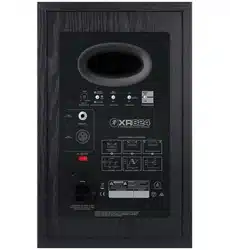Loading ...
Loading ...
Loading ...

5
Owner’s Manual
Owner’s Manual
Quick Start
We realize that you can’t wait to hook up your XR
Series Studio Monitors and try them out. Nevertheless,
please take the time to read this page NOW, and the rest
can wait until you’re good and ready.
There are a number of other settings you can make on
the back of the XR Series, but for now, just leave them
at the factory default settings.
1. Turn the Input Sensitivity Level [5] control on the back
of the cabinet down (fully counterclockwise) before
turning on the monitor for the first time.
2. Set the power switch [2] on the back panel off. This will
prevent you from accidentally connecting a hot signal
source to the monitor and getting a rude surprise.
3. Leave the low freq [7] and high freq [8] filter switches
at their normal positions.
4. Connect the line-level monitor signal from your mixer,
preamp, or other signal source to the 1⁄4" or XLR input
jack [4] on the XR Series Studio Monitor.
5. Connect the supplied AC power cord to the (1) IEC
socket on the back of the monitor. Plug the other end
into an AC outlet properly configured with the voltage
corresponding to the markings next to the IEC socket.
6. Start your signal source (8-track player, turntable, CD
player, DAW, or whatever), but leave the master volume
control on the mixer or preamp down.
7. Turn on the power switch [2] on the XR Series monitor.
The LED on the front panel will illuminate.
8. Slowly turn up the Input Sensitivity Level [5] control
on the back of the monitor to the Normal position
(MAX).
9. Adjust the master volume on the mixer or preamp to a
comfortably loud listening level. If the XR monitor gets
loud really fast, turn down the Input Sensitivity Level
control to its center position (12 o’clock) to provide
more volume control on the mixer or preamp.
An Extremely Important Note
on XR Series Bass Response
and Your Control Room
Your new XR Series monitors achieve their best bass
response in a room that’s optimized for bass reproduction.
A lot of factors can conspire to thwart the XR’s extended
low frequency — including room shape, room volume and
acoustical treatment. This is not a cop-out or an apology.
It’s plain old physics in action. Luckily we’ve armed you
with some compensating controls that you can use to
optimize the frequency response of the speakers in your
particular room. Consider the following:
Low-Frequency Response
When you put your XR series monitors
in a corner or up against walls, their bass
characteristics change. The apparent
loudness of the low frequencies increases when the
monitors are placed close to a wall, and even more so
when they are placed in a corner. The Acoustic Space
[6] switch must be set correctly. Adjust the Acoustic
Space switch setting accordingly to avoid muddy or
exaggerated low frequency response.
High-Frequency Response
XR series monitors are designed to provide a smooth
frequency response throughout the mid and high range.
Nevertheless, you may decide that you need a little more
or a little less high frequencies in your monitors while
you are mixing. The high freq filter [8] switch provides
a gentle boost or cut to the tweeter. Remember that
boosting the high frequencies in the monitors can result
in a duller mix, while reducing the high frequencies can
result in a brighter overall mix.
Additional Tidbits of Wisdom
• Never listen to loud music for prolonged periods.
Please see the Safety Instructions on page 2 for
information on hearing protection.
•
When you shut down your equipment, turn off the XR
Series studio monitors first to prevent thumps and
other noises
generated by any upstream equipment from
coming out the
speakers. When powering up, turn on
the monitors last.
• Save the shipping box! You may need it someday.
• Save your sales receipt in a safe place. It’s your
warranty!
Placement
XR Series monitors were designed to be placed in a
vertical position. If you find it necessary to place the
speakers in a horizontal position (on their sides), place
them so that the woofers are toward the inside; that is,
so the woofers are closest to each other. This provides
the best low-frequency summing and overall imaging.
When the monitor is operated at high sound pressure
levels, a fair bit of heat can be generated by the internal
power amplifiers. These internal amplifiers are part of
the rear panel electronics assembly. To ensure adequate
ventilation, the rear of the monitor should be placed at
least three inches away from the wall.
Loading ...
Loading ...
Loading ...
